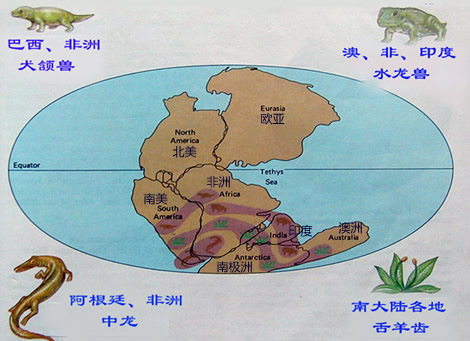(单词翻译:单击)
When it was realized that ancient tapirs had existed simultaneously in South America and Southeast Asia a land bridge was drawn there, too. Soon maps of prehistoric seas were almost solid with hypothesized land bridges—from North America to Europe, from Brazil to Africa, from Southeast Asia to Australia, from Australia to Antarctica. These connective tendrils had not only conveniently appeared whenever it was necessary to move a living organism from one landmass to another, but then obligingly vanished without leaving a trace of their former existence. None of this, of course, was supported by so much as a grain of actual evidence—nothing so wrong could be—yet it was geological orthodoxy for the next half century.
当发现古代的貘同时存在于南美洲和东南亚,他们又架起了一座陆桥。过不多久,史前海洋的地图上几乎到处都是假想的陆桥──从北美洲到欧洲,从巴西到非洲,从东南亚到澳大利亚,从澳大利亚到南极洲。这种鬈须状的连接物出现得很快,只要需要,把一种生物从一个大陆搬到另一个大陆,消失得也很快,最后就无影无踪了。当然,这种东西没有一丝一毫的根据──是大错特错的。然而,在此后的半个世纪里,它是地质学的正统观念。
Even land bridges couldn't explain some things. One species of trilobite that was well known in Europe was also found to have lived on Newfoundland—but only on one side. No one could persuasively explain how it had managed to cross two thousand miles of hostile ocean but then failed to find its way around the corner of a 200-mile-wide island. Even more awkwardly anomalous was another species of trilobite found in Europe and the Pacific Northwest but nowhere in between, which would have required not so much a land bridge as a flyover. Yet as late as 1964 when the Encyclopaedia Britannica discussed the rival theories, it was Wegener's that was held to be full of "numerous grave theoretical difficulties."
有的事情,即使陆桥也无法解释。人们发现,有一种在欧洲很著名的三叶虫在纽芬兰也生活过──但只是在该岛的一侧。谁也无法令人信服地解释,三叶虫怎么能跨越3000公里的汹涌大海,却又绕不过那个300公里宽的岛角。另一种三叶虫的情况更是反常,它出现在欧洲和美国西北部的太平洋沿岸,而中间地带却不见踪影。这与其说需要一座陆桥,不如说需要一座立交桥。然而,直到1964年,《大英百科全书》在讨论各种不同的理论时,倒是把魏格纳的理论说成是“充满了许多严重的理论问题”。


